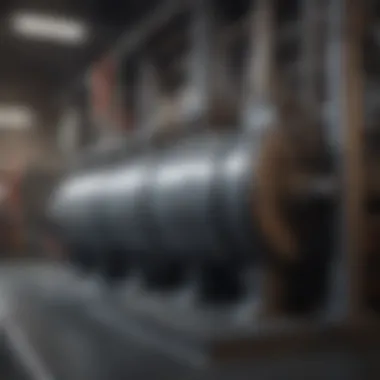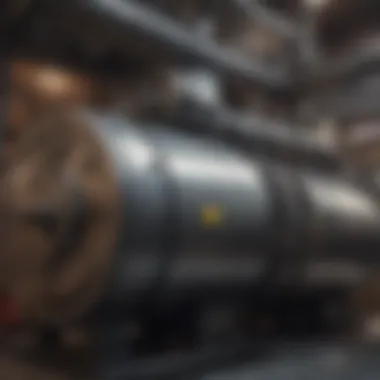Power Generation Boilers: Comprehensive Overview


Overview of Research Topic
Power generation boilers serve as vital components in thermal power plants. Their role in converting fuel into steam, which drives turbines to generate electricity, makes them indispensable in the energy production landscape. This article dives deep into the intricacies of power generation boilers, examining their design, operation, types, and their environmental and efficiency factors.
Brief Background and Context
Historically, boilers have been pivotal in the industrial and energy sectors. They have evolved significantly, driven by advancements in technology and growing concerns about environmental impact. Traditionally fueled by coal, the contemporary boiler landscape is diversifying to include natural gas, biomass, and even waste by-products. Such transitions reflect the changes in policy and societal expectations regarding sustainable energy production.
Importance in Current Scientific Landscape
As we aim for a more sustainable future, power generation boilers are under scrutiny. Understanding the technical aspects of these systems provides insights into optimizing energy efficiency and reducing emissions. Scenarios of energy generation must adapt to regulatory changes and innovations in technology. The implications for scientists, engineers, and policymakers are considerable as they navigate this evolving landscape.
Methodology
Research Design and Approach
This article adopts a mixed research approach. It draws on both qualitative and quantitative data. Analyzing various types of boilers allows for a richer understanding of their operational frameworks and efficiencies. Insights from industry reports and academic papers provide a solid foundation for the arguments presented.
Data Collection Techniques
Data for this exploration were gathered from a variety of sources. These include:
- Industry journals and publications.
- Case studies from established power plants.
- Government and environmental agencies' reports.
- Interviews with professionals in the field.
Employing diverse sources ensures a comprehensive view of the topic.
This research emphasizes the versatility of modern power generation boilers and their adapting role in a rapidly changing energy sector.
Preamble to Power Generation Boilers
Power generation boilers play a critical role in the modern energy landscape. Their design and operation underpin the efficiency and reliability of energy production systems. By understanding boilers, one can appreciate how they transform various fuel sources into usable energy. This section will explore the essential aspects of power generation boilers, reflecting on their historical development and current relevance in energy production.
Historical Context
The history of power generation boilers dates back to the early industrial revolution. These boilers were initially designed to generate steam for engines, paving the way for mechanized production. Over time, they evolved significantly, incorporating advancements in materials and design.
In the early 20th century, the focus shifted towards increasing efficiency and reducing emissions. This led to the advent of water-tube boilers, which provided greater steam pressure and efficiency compared to their fire-tube counterparts. Furthermore, the latter half of the 20th century saw increasing concerns regarding environmental impacts, prompting innovations aimed at reducing pollutant emissions.
"Boiler technology has continuously adapted to meet the demands of a changing energy landscape, driven by both economic and environmental factors."
Understanding the historical context of boilers is essential, as it highlights how technology has progressed in response to societal needs. The development of regulations and safety standards has also been a significant aspect of the evolution of boiler technology.
Importance in Energy Production
Power generation boilers are central to the generation of electrical energy through steam. They operate by converting water into steam using various heat sources. This steam, under high pressure, is then used to turn turbines, which generate electricity.
Several critical points underscore the importance of these boilers:
- Efficiency: Modern boilers are designed to maximize thermal efficiency, directly impacting the cost of energy production.
- Flexibility: Boilers can utilize a range of fuel sources, adapting to market conditions and resource availability.
- Reliability: Well-designed boiler systems enhance the stability of energy supply, crucial for both industrial and residential users.
- Environmental Compliance: Advances in boiler technology have made it possible to meet stringent environmental regulations, reducing emissions and promoting sustainability in energy production.
In summary, power generation boilers are not only vital components of power plants but also essential elements in the quest for more sustainable energy solutions. Understanding their historical significance and operational importance provides valuable insights into the future of energy production.
Basic Design and Operation Principles
Basic design and operation principles are fundamental for understanding the efficiency and functionality of power generation boilers. These principles establish the framework through which boilers operate, guiding design choices and enabling effective energy conversion. A solid grasp of these principles is imperative for those involved in energy production, as they influence both the performance of the system and its environmental impact.
Key Components of Boilers
The key components of boilers play a crucial role in their overall performance. A typical boiler consists of:
- Burner: This is where fuel and air mix, and combustion occurs.
- Combustion Chamber: A space where the burning of fuel takes place, generating heat.
- Heat Exchanger: This component transfers heat from the combustion gases to water or steam without mixing the two.
- Drum: Holds water that is converted into steam. It can be located at the top (in water-tube boilers) or central (in fire-tube boilers).
- Piping Systems: These connect various components, facilitating the flow of water, steam, and combustion gases.
Each of these components has its own specific function, and their design significantly impacts efficiency and operation.


Heat Transfer Mechanisms
Heat transfer mechanisms in boilers comprise three primary methods: conduction, convection, and radiation.
- Conduction: This is the transfer of heat through solid materials. In a boiler, this occurs in the walls of the heat exchanger, where heat moves from the hot gases to the cooler water.
- Convection: This transfer method involves the movement of fluids. Heated gases rise and circulate, transferring heat to surrounding surfaces.
- Radiation: Heat is emitted from the surface of hot materials. In a boiler, some heat loss can occur due to radiation, particularly if the surfaces are not insulated properly.
Understanding these mechanisms is vital for optimizing boiler design and ensuring maximum efficiency during operation.
Combustion Process Overview
The combustion process in boilers is complex and requires precise control. It begins with the mixing of fuel with air, leading to ignition. The ideal combustion process maximizes energy output while minimizing emissions. Critical factors include:
- Air-Fuel Ratio: The right proportion ensures complete combustion. Too much air can cause inefficiency, while too little can result in harmful emissions.
- Flame Temperature: Higher temperatures generally improve efficiency, but also increase NOx emissions. Managing flame temperature is crucial for performance and compliance with environmental regulations.
- Burner Design: Innovative burner designs contribute to better mixing, more efficient combustion, and reduced emissions.
In summary, the combustion process is central to boiler operation, influencing not only efficiency but also environmental impact. Understanding these basic design and operational principles allows for more effective management of power generation boilers.
Types of Power Generation Boilers
Understanding the types of power generation boilers is crucial for several reasons. Firstly, each type of boiler has its own specific design, functionality, and efficiency. Knowing these differences can help in selecting the right type for a particular application or installation. Additionally, the choice of boiler impacts energy production efficiency and environmental compliance. This section will explore different types of boilers commonly used in power generation, examining the unique attributes and applications associated with each.
Fire-tube Boilers
Fire-tube boilers are among the most traditional designs used in power generation. In these systems, hot gases from a furnace pass through tubes that are surrounded by water. This design allows for effective heat exchange. Fire-tube boilers are typically compact, making them suitable for smaller energy installations.
One benefit of fire-tube boilers is their relatively low initial cost. They require less complex control systems, which can lead to lower expenditures in terms of setup and maintenance. However, they have limitations in pressure handling, which may impact larger scale operations. Common applications often include commercial heating and smaller industrial processes.
Water-tube Boilers
In contrast, water-tube boilers circulate water inside the tubes and use hot gases to heat the surrounding water. They are preferred for high-pressure and high-capacity applications, making them suitable for large power plants. The design allows for quicker heat transfer, which can significantly increase efficiency.
Water-tube boilers come with notable advantages, including their ability to handle higher pressures and temperatures. This feature plays a key role in enhancing thermal efficiency and output. Industries often choose water-tube systems for their capability to adapt to changing load demands, promoting a more responsive operation.
Electric Boilers
Electric boilers operate differently than traditional fuel-based systems. They utilize electric heating elements to produce steam or hot water. Their operation does not rely on combustion, which results in zero emissions at the point of use. This characteristic appeals to installations focused on sustainability and reduced environmental impact.
While electric boilers are more efficient in terms of energy conversion, they can be limited by the geographical availability of electricity and the cost of electrical energy. Generally, they are suited for applications where electricity is readily available and can be economical, particularly in regions with low energy costs.
Renewable Energy Boilers
The shift towards renewable energy sources has led to the development of specialized boilers designed to utilize biomass, solar energy, and other sustainable fuels. Biomass boilers burn organic materials like wood pellets, agricultural residues, or waste for energy generation. This not only aids in waste management but also contributes to a lower carbon footprint.
Renewable energy boilers help diversify fuel sources and can be integrated with existing systems to enhance overall energy sustainability. As regulations tighten on emissions, focusing on renewable solutions becomes increasingly significant. These boilers can greatly contribute to decreasing greenhouse gas emissions and promote more sustainable energy practices in the power sector.
Fuel Sources for Power Generation Boilers
Fuel sources are a critical element in the operation of power generation boilers. The choice of fuel not only impacts boiler efficiency but also has far-reaching effects on environmental sustainability, operational costs, and regulatory compliance. Understanding various fuel options helps stakeholders make informed decisions that optimize performance and minimize negative impacts. This section delves into the predominant fuels used in power generation boilers, emphasizing their characteristics, benefits, and challenges.
Natural Gas
Natural gas is regarded as one of the cleanest fossil fuels, making it a popular choice for modern power generation. It burns more efficiently than other fossil fuels, producing lower levels of carbon dioxide and particulate emissions. This reduced environmental footprint can help facilities comply with stringent emission regulations. Additionally, the infrastructure for natural gas delivery is well established, which simplifies logistics for many power plants.
"Natural gas provides a competitive edge in cost efficiency and environmental acceptance for power generation."
However, while natural gas is generally cleaner, it is still a hydrocarbon and contributes to greenhouse gas emissions. Moreover, the extraction process of natural gas, particularly through hydraulic fracturing, raises environmental concerns, including potential groundwater contamination and induced seismicity. Therefore, while it offers clear benefits, stakeholders must weigh these against the environmental considerations.
Coal
Coal has long been a primary fuel for power generation globally due to its availability and cost-effectiveness. It is abundant in many parts of the world and provides significant energy output, making it an appealing choice for plants seeking to maximize production.
Despite its advantages, coal combustion is among the most significant sources of air pollution. It releases high levels of carbon dioxide, sulfur dioxide, and various other contaminants. The environmental impact of coal has led to stricter regulations and a push towards cleaner alternatives. Efforts to mitigate these impacts include the implementation of carbon capture technologies and improving combustion techniques. Nonetheless, the overall trend is a gradual decline in coal usage as more nations commit to reducing their carbon footprint.
Biomass
Biomass refers to organic materials, such as plant and animal waste, that can be used as fuel. It is considered renewable because it can be replenished naturally over a relatively short time frame. The use of biomass in power generation aids in waste management and contributes to energy sustainability.


However, the sustainability of biomass depends on its source and production methods. Not all biomass fuels are created equal; some may lead to deforestation or other ecological damage if not managed properly. Additionally, while biomass combustion produces lower carbon emissions compared to coal, it still emits some pollutants, necessitating appropriate technology to limit harmful emissions. Therefore, when implemented responsibly, biomass can contribute to a more sustainable energy future.
Oil and Other Fuels
Oil has historically been used as a fuel source for power generation, particularly in areas where natural gas is not accessible. It can be easily transported and has a high energy density. Despite these advantages, oil-fired power plants are experiencing a decline in favor of cleaner fuels. The volatility in oil prices and geopolitical issues surrounding its supply add to the challenges of relying on oil for energy production.
Other fuels, less commonly used for large-scale power generation, include kerosene and liquid petroleum gas (LPG). These options may be more suitable for smaller or localized systems due to their specific properties or availability. Like oil, they tend to produce higher emissions than cleaner alternatives, which raises concerns regarding air quality and climate change impacts. Their use is becoming more limited as regulations tighten and a transition to sustainable sources gains momentum.
Efficiency and Performance Factors
Efficiency and performance are critical aspects of power generation boilers. These factors directly impact the overall cost-effectiveness, environmental sustainability, and reliability of power systems. As energy demands grow globally, understanding how to maximize efficiency becomes increasingly essential for both economic and environmental considerations.
Boiler Efficiency Metrics
Boiler efficiency metrics determine how effectively a boiler converts fuel into usable energy. They are essential for assessing performance and energy savings. The most common metrics include:
- Thermal Efficiency: This measures the heat transfer efficiency from the combustion process to the water or steam. A higher thermal efficiency indicates less fuel waste and reduced emissions.
- Combustion Efficiency: This focuses on how well the fuel burns within the boiler. Higher combustion efficiency leads to minimal unburned carbon significantly impacting emissions and fuel consumption.
- Overall Efficiency: This metric combines thermal and combustion efficiencies. It gives a complete view of the boiler’s performance, including heat losses and other operational factors.
Understanding these metrics allows engineers to make informed decisions when selecting or retrofitting boilers, ensuring they meet energy demand while optimizing costs.
Heat Recovery Systems
Heat recovery systems are designed to reclaim and utilize waste heat generated during the boiler's operation. They play a vital role in improving overall efficiency by harnessing energy that would otherwise be lost. Key components include:
- Economizers: These devices capture residual heat from flue gases and preheat the feedwater, reducing the energy required to bring water to steam.
- Heat Recovery Steam Generators (HRSG): These are used in combined cycle power plants, where they capture exhaust heat and convert it back into steam for further energy production.
- Combined Heat and Power (CHP) Systems: CHP integrates heat and power generation in a single system to improve overall efficiency.
Implementing heat recovery can lead to significant cost savings, lowering fuel consumption and emissions. It is increasingly becoming a standard practice in modern boiler operation.
Impact of Maintenance
Proper maintenance practices are crucial for ensuring that power generation boilers operate at peak efficiency. Maintenance impacts equipment longevity, safety, and performance. Key maintenance considerations include:
- Regular Inspections: Frequent checks help to identify early signs of wear and inefficiency, enabling proactive fixes before costly breakdowns occur.
- Cleaning: Accumulation of soot and other residues can severely reduce efficiency. Routine cleaning helps maintain optimal heat transfer and combustion efficiency.
- Calibration: Ensuring that all instruments and controls are accurately set and functioning correctly allows the boiler to operate at designed efficiency levels.
Effective maintenance strategies lead to lower operational costs and extend the life of the boiler.
Environmental Impacts of Power Generation Boilers
Understanding the environmental impacts of power generation boilers is critical in today’s context of climate change and environmental conservation. These boilers are a key element in generating electricity, but they do not come without consequences.
The role of power generation boilers extends beyond mere electricity production. They are often at the center of discussions about emissions, sustainability, and the regulatory frameworks designed to mitigate harmful impacts. As such, it is essential to evaluate the specific elements of their operation, considering both benefits and considerations.
The emissions produced by these boilers can have substantial short-term and long-term effects on air quality and human health, making this a focal point for regulations and technological improvements. Analyzing these impacts leads to a more comprehensive understanding of our reliance on various energy sources and influences strategies for transitioning toward more sustainable practices.
Emissions and Regulations
Power generation boilers, depending on their fuel sources, can emit pollutants such as carbon dioxide, nitrogen oxides, sulfur dioxide, and particulate matter. Carbon dioxide is a key greenhouse gas, contributing to climate change. Nitrogen oxides and sulfur dioxide can lead to acid rain and respiratory issues in humans when released into the atmosphere.
To address these emissions, various regulations at the national and international levels have been established.
- The Clean Air Act: Enforced in the U.S., it sets limits on common pollutants emitted from boilers.
- European Union Emission Regulations: Focus on reducing emissions across member states through a cap-and-trade approach.
These regulations push for cleaner technologies and operational standards, promoting innovation. Technologies such as flue gas desulfurization (FGD) units and selective catalytic reduction (SCR) systems are examples of advancements aimed at reducing harmful emissions.
"As regulations tighten, the need for efficient emission control technologies becomes more urgent, guiding innovation in the boiler sector."
Impact on Local Ecosystems
The operation of power generation boilers can significantly affect local ecosystems. The main environmental concerns include water usage and thermal pollution. Many boilers require substantial amounts of water for cooling purposes. This can deplete local water resources and affect aquatic life.
Thermal pollution occurs when water discharged back to rivers or lakes is significantly warmer. Elevated temperatures can disrupt local habitats, adversely affecting fish and other wildlife.
Furthermore, air pollutants can settle on land and water bodies, posing threats to flora and fauna. The presence of heavy metals in the soil can lead to bioaccumulation in food chains, impacting not only wildlife but human populations as well.


Technological Advancements
Technological advancements in power generation boilers are pivotal in enhancing efficiency, reducing emissions, and improving overall operational reliability. The integration of new technologies has fundamentally changed the landscape of boiler operations, enabling the adaptation to a rapidly evolving energy sector. As a result, these advancements not only impact economic factors but also address growing environmental concerns.
Innovations in Boiler Design
The innovations in boiler design focus on increasing efficiency and minimizing energy lost during operation. The introduction of advanced materials, such as high-temperature alloys and composites, has resulted in lighter and more durable components. These materials can withstand extreme conditions, leading to longer service life and reduced maintenance costs.
Additionally, designs have shifted towards modularization, enabling easier assembly and disassembly for maintenance. Utilization of computational fluid dynamics (CFD) during the design process aids in optimizing combustion processes and heat transfer efficiency.
Moreover, innovations such as circulating fluidized bed (CFB) boilers and supercritical steam generators represent significant strides in design technology. These systems provide higher thermal efficiency and the ability to burn a wide variety of fuels, making them adaptable to different energy sources.
Automation and Control Systems
Automation and control systems have revolutionized the operation of power generation boilers. Smart technology plays a crucial role in enhancing boiler performance and monitoring. Advanced sensors and control algorithms allow for real-time data acquisition and analysis, leading to more informed decision-making.
The implementation of technologies like Internet of Things (IoT) empowers operators to monitor systems remotely. Predictive maintenance is a key benefit; operators receive alerts about potential issues before they escalate, minimizing downtime.
Furthermore, sophisticated control systems can adjust operational parameters dynamically, ensuring optimal performance under varying load conditions. This adaptability improves fuel efficiency and can lead to substantial cost savings.
"With the integration of intelligent automation, plants can operate in a more efficient and environmentally friendly manner."
Regulatory and Safety Standards
Regulatory and safety standards play a crucial role in the operation and design of power generation boilers. These standards ensure that boilers operate efficiently, safely, and in an environmentally responsible manner. Compliance with regulations helps prevent accidents, reduces environmental impact, and improves overall operational performance. Not only do these standards safeguard personnel and equipment, but they also maintain public trust in energy production facilities. Understanding the specifics of these regulations is essential for stakeholders in the power generation sector, including engineers, operators, and regulatory bodies.
International Standards Overview
International standards, such as those set by the International Organization for Standardization (ISO) and the American Society of Mechanical Engineers (ASME), establish norms for the design, manufacturing, and operation of boilers. These standards address critical aspects such as:
- Safety and Performance: Minimizing risks associated with boiler operation is paramount. Guidelines set specific safety measures throughout the design and operational phases.
- Quality Assurance: These standards define testing methods to ensure that all components meet required quality specifications.
- Environmental Considerations: Emission limits and operational efficiency play a significant role here. The standards often incorporate directives aimed at reducing pollutants.
By adhering to these International guidelines, boiler manufacturers and operators can promote safer, more efficient, and environmentally friendly practices globally.
National Regulations
Each country typically has its own set of regulations that are tailored to local conditions, resources, and policy objectives. In the United States, for instance, the Environmental Protection Agency (EPA) and state-level regulators establish criteria that power generation boilers must meet.
- Emission Standards: National regulations often set stringent limits on emissions, including sulfur dioxide, nitrogen oxides, and particulate matter, which impact air quality. Compliance is often enforced through regular inspections and reporting.
- Operational Protocols: These protocols outline how to maintain safe and efficient operations. They may cover maintenance schedules, emergency procedures, and operator training requirements.
- Impact Assessments: Before a power generation facility can commence operations, it may be required to undertake assessments to evaluate its environmental impact. This includes issues like noise pollution, habitat disruption, and others.
Engagement with national regulations ensures that power generation facilities not only produce energy but do so in a manner that prioritizes public health and environmental sustainability.
"Adhering to regulatory standards is not just a matter of compliance; it is a commitment to safety, quality, and environmental stewardship."
Understanding both international standards and national regulations enables stakeholders to adopt best practices when designing and operating power generation boilers, ensuring the long-term viability of energy systems.
Future Outlook for Power Generation Boilers
The future outlook for power generation boilers is a critical topic as it addresses how these systems will evolve to meet changing energy demands and environmental regulations. With escalating pressures from climate change and the shift toward renewable energy sources, power generation boilers must adapt. This section examines the trends, integration of renewable energy, and compliance with climate policies that will shape the future of these vital systems.
Trends in Boiler Technology
As the energy landscape continues to change, so does the technology behind power generation boilers. Some significant trends include:
- Modularity: Modular boilers allow for scalability and flexibility. They can be easily expanded in capacity as demand increases without extensive downtime.
- Advanced Materials: New materials are being researched and utilized. These materials can withstand higher temperatures and pressures, thus improving efficiency and longevity.
- Smart Technology: The rise of automation and IoT technology enables better control systems. This leads to optimized operations and predictive maintenance, reducing downtime and increasing efficiency.
"The adoption of smart technology in boilers signifies a shift towards precision and reliability, enhancing performance metrics while minimizing risks."
Impact of Renewable Energy Integration
Integrating renewable energy sources into boiler systems is becoming more prominent as the world pushes for sustainability. This integration provides several benefits:
- Hybrid Systems: Boilers can be designed to use a combination of traditional fuels and renewable sources, such as biomass and solar energy. This not only reduces dependence on fossil fuels but also lowers emissions.
- Flexibility: Boilers capable of utilizing various fuel sources can adapt better to fluctuating fuel availability and prices, ensuring steady energy production.
- Regulatory Compliance: The shift towards renewables helps fulfill stringent emission regulations and supports governments' sustainability goals.
Adaptation to Climate Change Policies
The pressures of climate change are reshaping the operational landscape of power generation boilers. Understanding these policies is essential for any stakeholders in this industry. Some key considerations include:
- Emission Reduction: Regulatory bodies are tightening emission standards. Manufacturers and operators must implement technologies to adhere to these regulations, such as carbon capture technologies that reduce the carbon footprint of power generation.
- Funding and Incentives: Governments may provide financial incentives for companies that implement cleaner technologies. Understanding these economic factors can guide strategic decisions in power generation.
- Lifecycle Assessment: An increasing number of policies are emphasizing the importance of assessing the environmental impact throughout a boiler’s lifecycle, from installation to decommissioning.
The future of power generation boilers is characterized by innovation and adaptability. Staying informed about these trends, investments in renewable energy, and regulatory changes is crucial for the sustainability and efficiency of power generation systems.



